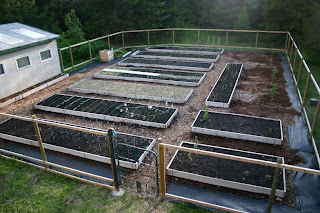Our outdoor garden is now completely planted. We could have planted some things (peas, potatoes, onion sets, garlic) earlier, but have been so busy with garden construction that some plantings were delayed a bit. Our area's last frost date is June 1, so the tender crops were planted according to schedule. We're still waiting on quite a few bareroot plants (daisies, butterfly bush, blanket flowers, hostas, astilbe, trillium, ferns) to make their appearance. Those got planted out about 3-4 weeks ago. I'm already looking forward to next year when we have some well established perennials to add greenery to our early spring garden.
Here are some pictures to show our progress outdoors. I'll post an indoor update later in the week.

Below is an astilbe (I think) planted out in the shade bed behind the greenhouse. This is the only bed that is mulched, eventually we'll put a layer of mulch on all the perennial beds.

A butternut squash. The winter and summer squash and cucumbers don't seem to mind the recent cool rainy weather.

Something really likes my swiss chard below. I can't figure out what it can be.. it's not Jeff, the dogs, a deer, or a rabbit... What could this be? This mystery pest has been chowing down on my chard, fennel, sunflowers, cabbage and kohlrabi. It's chewed things off at the stem and left a leaf or two as evidence. No snail trails have been spotted. Any ideas? We're putting out a garlic/cayenne/neem/soap spray to deter a variety of critters since we're stumped.

Our potato plants are poking their heads up out of the ground! I can't wait to for these to get bigger and to be able to harvest baby potatoes. We planted the potatoes in 10 inch deep trenches in the garden. As the potatoes grow bigger we'll gradually add more the dirt back on them.

Below are some radishes planted under a pea trellis. I got bored of trying to plant in straight lines everywhere so started planting shapes in the garden. Why not? These radishes got planted in a heart shape, the garlic in a spiral, and the carrots in wavy parallel lines.

Here are some pea trellises that I made. Not the most durable things in the world, we'll see how they do. For the other trellises that are needed, we've decided just to use stakes and chicken wire. That seems like the most practical, affordable and movable trellis style.

As neither Jeff or I had ever grown onions before, we're growing some from sets and some from seeds to see what works best for us. Betcha can guess which ones are from sets and which from seeds. The seeded onions (on the right, obviously) were started February 1st in our germination station, moved to the solarium, and then the greenhouse before being transplanted about 3 weeks ago. I'm not sure what we should have done differently to make these bigger. They weren't even close to being root-bound, so I don't think pot size was a problem. I know that with other plants (tomatoes, peppers) I spent too much time trying to harden things off - about 4 weeks. I guess there is a good chance that this is what I did wrong with the onions. Next year I think I'll keep all of my transplants in the solarium and start hardening off plants just a week before planting. Any additional input on growing better onion transplants?

I did OK growing marigold transplants. This is the first marigold to flower in our garden. About 40 of these are planted in the flower bed, among the carrots and tomatoes.

Our perennial/annual flower bed is pictured below. Eventually this will contain winter hardy gladiolas, stargazer lilies, lavender, lupine, blanket flowers, goblin flowers, shasta daisy, alaska daisies, bee balm, butterfly flower, coreopsis, creeping thyme, and phlox. In this picture you can pretty much just see some zinnias, marigolds and lilies. The zinnias and marigolds were started from seed about 8 weeks ago and I'm pretty happy with the way those turned out.

Well, that is what we've been up to. Any input on things we can do to help control pests or for growing better transplants next year is appreciated.

 The greenhouse violas are sprawling. I know it's too warm for them but I can't bear to say goodbye to these plants. I tried to kill them without success this past fall and they sprung up in the greenhouse in February after freezing temperatures and months without water. The faces are getting a bit bleached in the afternoon sun.
The greenhouse violas are sprawling. I know it's too warm for them but I can't bear to say goodbye to these plants. I tried to kill them without success this past fall and they sprung up in the greenhouse in February after freezing temperatures and months without water. The faces are getting a bit bleached in the afternoon sun. This is a whatchamacallit. It's a perennial of some sort and one of the only perennials that is blooming outdoors. It looks like we won't see much excitement in the perennial flower bed until next year.
This is a whatchamacallit. It's a perennial of some sort and one of the only perennials that is blooming outdoors. It looks like we won't see much excitement in the perennial flower bed until next year. I've got a couple baskets of geranium that are basking in the heat of the greenhouse. These really brightened up the place and made it look a lot less utilitarian.
I've got a couple baskets of geranium that are basking in the heat of the greenhouse. These really brightened up the place and made it look a lot less utilitarian.




























